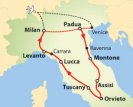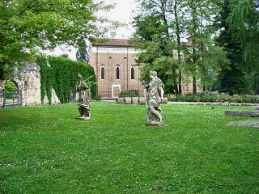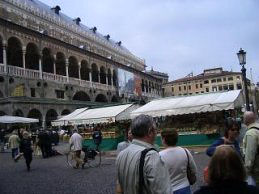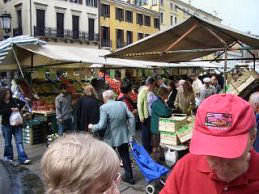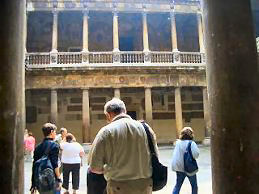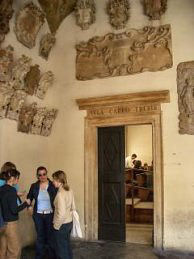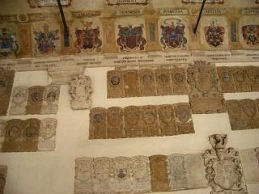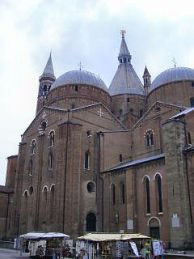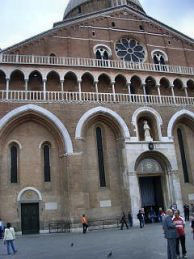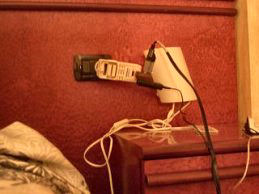I fell right asleep, but I woke up at about midnight. I could not get back to dreamland. I am generally a sound sleeper, but Sue's snoring was too loud and too erratic. I tried the earplugs that ETBD thoughtfully provided, but they did not help. You can't send a boy to do a man's job. After an hour or so of tossing and turning I got up and worked on my journal for more than an hour. At that point I was tired enough to fall asleep in a tornado. Sue reported in the morning that she got a good night's sleep, but I didn't see how she could have.
I was very stiff when I got out of bed. I did all of my stretching exercises. I still felt stiff, so I did a second set.
It took a very long time – at least ten minutes – for the hot water to make it up to room 55, which was the furthest room in the hotel from the outside door.
We went to breakfast and found an empty table. The cappuccino was very good. The meal itself was no more than a roll with honey and juice (peach for me, pear for Sue). It was the weakest offering that I had yet encountered in Italy.
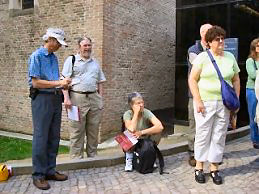
We went through the same type of decompression ritual as we did in Milan in 2003 for the refectory that contained Il Cenacolo. Although the outside of the chapel was plain, the interior was really something to see. The ceiling was blue with stars. There were 40 or so panels of frescoes depicting the New Testament story from before the birth of Mary until after the resurrection of Jesus.
The large last judgment scene at the back was in the worst condition, but they have evidently worked very hard to preserve as much as is left. The blues and golds have almost all fallen off to some extent. It was restored in May 2001-March 2002. Their current policy is not to repaint missing areas any more. Now they just clean off the dirt and grime. Carla explained that the secret of preserving frescoes is to keep the plaster itself from falling apart. So now they concentrate on the entire structure, not just the painted walls.
Giotto was a student of Cimabue (accent on the first syllable!), but he quickly eclipsed his master in both technique and reputation. He was way ahead of his time. He introduced real people, real backgrounds, and expressive faces. He made the first serious effort towards perspective. His paintings were not exactly lifelike, but they were much more expressive than the Byzantine standards of his day. Unfortunately he was so much more advanced than everyone else in his techniques that it took 80 years for the world to catch up, and in his own time he was respected but not revered.The sculptures in the chapel by Giovanni Pisano were also quite impressive. All in all, this was a great way to start the tour. I felt really fired up even though my back was definitely giving me problems.
I took photos of the Café Pedrocchi as we walked by. Carla explained that it was opened in 1831 as a place for Paduans (Padovans?) to come to talk freely. It had three rooms – red, white, and green. People could sit in the green room without ordering anything. This promoted lots of political discussion because poverty-stricken students and teachers could join in the argument. Padua has always been one of the most intellectually free towns in all of Italy. Now the cafe is owned by the town, and the green room still is open to the public.
We returned to the Palazzo di Ragione. Unlike the situation on Sunday, the markets were still bustling with activity. Carla explained that the architect who designed the lead roof of the palazzo was a Venetian ship designer. He shaped it like a keel. The design allowed him to create a large hall with no internal supporting columns or walls. In 2005 it was being used for art exhibitions and the like.Chapter 2 of the Dachshund Chronicles: I tried to get a photo of a black dachshund that I saw being walked by a lady. He was only a few feet away, but I missed him. He just managed to duck behind something before I snapped him in both of the first two photos. He was all too visible in the third photo as he lifted his leg to pee.
I learned that Padua's flag is a red cross on a white background. I didn't notice one flying anywhere in town.
We happened upon a “neolaureato,” a guy who had recently graduated. He wore a large laurel wreath over one shoulder and carried a bottle of wine. He had a sheepish expression on his face as he was led around by his friends. I later saw another young man who wore on his head a laurel wreath Roman style. I also noticed a warning in the university to the new graduates, but I did not have time to read and translate it.
The University of Padua was founded in 1222 as a law school. They later added a second faculty for “arte,” which included not just arts but science as well. According to Carla the only thing that they have never taught here is architecture (?). The school's most famous faculty member was Galileo Galilei. He is said to have considered it his best period professionally. There have been many famous alumni, especially in medicine. William Harvey, who discovered the circulatory system, studied here until 1602. The first female graduate of any university was Elena Lucrezia Piscopia, who received her degree in 1678.
We started our tour of the university with the primary building located in a courtyard off of one of Padua's main street. It is indeed impressive. When you walk through the door, you definitely get the impression that you have stepped back many hundreds of years. I took plenty of photos. Then we went up to the Aula Magna, a huge lecture hall. There are many coats of arms on the wall. They represent the families of the rectors, who, at one time were chosen by the students. Outside of the Aula Magna is the “room of forty,” which contains the portraits – recently done, but in Byzantine style – of forty of the most famous foreign graduates. A large wooden podium, supposedly used by Galileo, was also on exhibit there. In a clear a case of temporary cerebral rectal inversion, I did not take a photo of it. We then were allowed to look at the fascinating medical theater, which was constructed in 1594 and used for 368 years thereafter. This was the first such building in the world. There were five or six rows where hundreds of students could stand and look down at the cadavers. Somehow the university got dispensation from the church to cut up cadavers for medical research once in a while. If they hadn't, western medicine may have been set back a century or so.We learned that the river in this part of town was paved over in 1966. Now the street named Ponti Romani marks where it once ran.
The last stop on our tour was the basilica of St. Anthony, who was a Portuguese noble who landed accidentally in Sicily during a storm. He had heard about Francis of Assisi, and so he came to Italy to meet him. He immediately decided to become a Franciscan. He came to Padua in June 1231 and spent the last two years of his life, which ended at age 36, there. He was famous for his outstanding charisma. Everyone sought his sainthood immediately upon his death.
Construction of the basilica also began as soon as Anthony died. One of the reasons that the shape of the complex is so peculiar is that they had to keep enlarging it to accommodate larger and larger crowds. It was completed in 1310. Donatello, who lived in Padua from 1443-1453, was one of the artists who worked on the interior. In addition, he created in front of the piazza a bronze statue of a military captain, Gattamelata, mounted on a horse. The statue was not unusual by today's standards, but it was the first such statue with a horse, and the first with a military figure. Donatello also designed the original altar, which included thirty of his pieces. Carla told us that at one time it was considered unfashionable and was disassembled. Centuries later the people realized the error of their predecessors' ways, but by then no record could be found indicating which statue went where. So the current unimaginative alignment probably did not correspond closely with Donatello's intent.It was hard to believe that the basilica itself was actually not in Italy at all but was instead part of the Vatican state, as were the pilgrimage sites in Assisi and Loreto. An Italian criminal could theoretically ask for asylum there. The basilica was hardly damaged in World War II, probably because of this fact. The Paduans brought all of their precious artwork to the basilica in order to protect the pieces from allied bombing.
The inside of the church was too busy for the taste of anyone except a dedicated pilgrim. It was just loaded with tombs and crypts. Some were small; some were large and ornate. No one in the church seemed to pay much attention to any of these except for the tomb of St. Anthony and the chapel of the reliquaries. The tomb itself was surrounded by pictures and medals placed by people who claimed to have been cured by St. Anthony. I considered placing one myself. I had prayed for St. Anthony to cure the blister on my second toe. Well, it wasn't quite cured, but it was a lot better after I prayed, changed socks, and put a Band-Aid on it.
The chapel of the reliquaries contained the basilica's most precious relics – the tongue, jaw, and teeth of St. Anthony. People were lined up for quite a ways to kneel and pray in front of them. Anthony was a famously popular preacher. These were the tools of his trade. The inevitable piece of the true cross was also on display here.
The church also featured frescoes by the first two artists to come close to reaching Giotto's stature late in the 14th century. I found their names later: Altichiero da Zevio and Jacopo Avanzo.
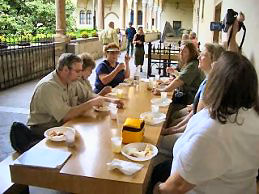
One of the sandwiches contained shaved horsemeat. I asked Nina's advice on whether Italians drink red or white wine with horse. Sue and I were the only ones at our table brave enough to try a horsemeat sandwich. Everyone asked us to try to describe its flavor, but the only word to describe it that I could come up with was “Alpo.” Actually it was OK, but when I went back for seconds, I was not disappointed that there were no more horsemeat sandwiches. The strawberries were not true “fragole.” Someone said that they were from California. The best part of the meal in my humble opinion was the cheese.
We had the rest of the afternoon to ourselves. From the desk clerk Sue gleaned the location of a likely-sounding “electric shop,” which was easily within walking distance of the hotel. This sounded better than the suggestion of the desk clerk of the previous evening whose plan involved taking a city bus to a vaguely identified location that might or might not have an appropriate store. The fly in the ointment was that the electric shop, like almost everything else in this country, closed its doors from 1 to 3:30.
Sue and I racked out in our room until 3:30. Then Sue and Patti decided that they wanted to go out on their own. They must have allowed Tom to tag along. The adrenaline was starting to wear off for me, and I felt really drained. I stayed in the hotel room and worked half-heartedly on my journal. I took another nap at about 5:30. Then I got up and tried to shower. Tom knocked on the door just as I was beginning to get a little hot water. He informed me that they had succeeded at obtaining a fuse, but it had been a near thing.
Sue came in a little after I was done with my shower. She informed me that they had had a difficult time finding the right place – it was a hardware store that was in the basement of an appliance store – and then in getting them to understand what she wanted. She swore that this time she pronounced “fusibile” correctly, but the clerk still didn't understand. Fortunately she had the bad one with her. She bought three replacements for only €,90. I thought that she was justifiably proud of herself.
Now came the moment of truth. Sue put the fuses in her machine. She plugged it in. We said a little prayer to St. Anthony and crossed our fingers to ward off the evil eye. Then she turned it on. Evviva! It worked. Now we should both be able to get some sleep.Lunch had inspired Sue to buy some true “fragole,” the tiny strawberries grown in the mountains of Italy. We each ate a handful. They tasted a little bitter.
Most of the restaurants were closed. Monday night is a bad time to do anything – even eat – in Italy. The four of us went out in search of a suitable eating establishment. The only requirement seemed to be that they have spaghetti (for Patti). This should not have proved difficult, and in fact it didn't. Near the basilica we found a small restaurant named Al Santo. The waitress spoke only Italian; the diners did not. At the next table were some German students. Beyond them were some American businessmen. The latter weren't particularly boisterous, but I could nevertheless clearly hear half of what they said. Americans just seem to talk loudly.
I ordered pizza Al Santo. It was good. It had ham, mushrooms, tomatoes, and peppers. Sue had a lamb chop with potatoes and polenta. She said that it was delicious. Tom had noodles of some kind. Patti had spaghetti. We split a bottle of the house white wine. Tom had an espresso and Patti a caffelatte after dinner. Sue had a custard with berries for dessert. I sat on my hands.
We started to take a little passeggiata after dinner, but we headed back after only a few blocks. I for one was still exhausted.
I probably should have found an internet spot or at least called the office at some point during the day. Oh, well.
The college town of Padua would probably have been the ideal place to locate a book store in which to browse, but I did not have the energy. Oh, well.
I meant to look for the Murolo CD in a music store, but I never got out of the hotel. Oh, well.
I fully expected to go jogging and run around the Prato Della Valle a few times in the evening, but I never made it. Oh, well.
Idea: What if St. Anthony had remained in Portugal or Sicily? It is hard to imagine a world in which no Italians were named Tony.
